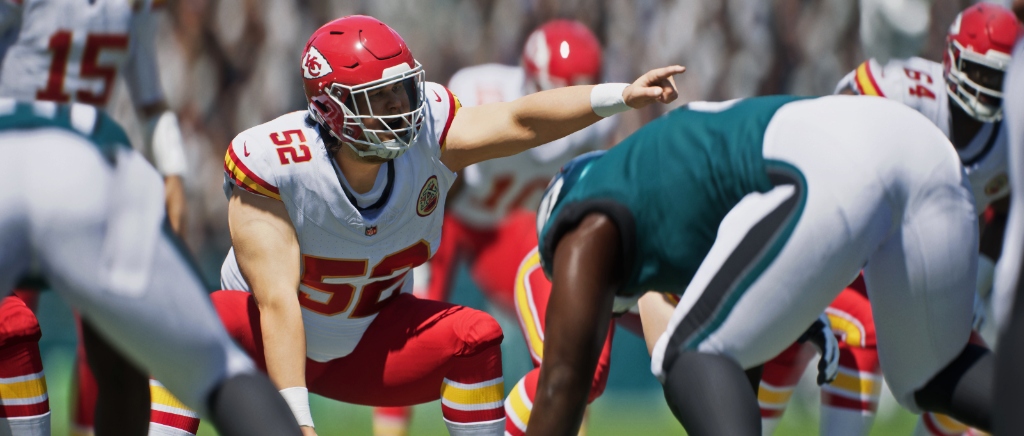When the EA Sports team invited me down to their Orlando campus as part of a press trip for an early preview of their upcoming football titles, I was far more excited by the re-launch of the EA Sports College Football franchise. It was the game that became such a big part of my life in high school and college, and has me more excited than any video game release in the last decade.
To me, Madden is what it is. I don’t get the game every year — I skipped Madden 24 — and tend not to play it as often or for as long. My issue with Madden isn’t the glitches that go viral, as that is just part of a modern simulation game that has so many combinations of things that can happen on any given play. My issue has been the game often feels the same year-to-year in terms of gameplay, and the kinds of modes I care about, namely Franchise, have felt like they’ve been on the backburner for awhile in favor of things like Ultimate Team.
As such, I wasn’t particularly hyped to get an early look at Madden 25, but after their presentation my interests were piqued. What they were talking about sounded like things I wanted to hear. For one, Franchise mode has been beefed up significantly (and I’ll have more to come on that with the lead designers on the mode), with 74 new dynamic storylines that keep the mode fresher for longer, and are season-long challenges rather than weekly checkpoints. As someone who has always preferred the career modes to online play, that’s exciting news and I’m genuinely intrigued by how it plays.
However, a good story mode only matters if the game itself plays well. Every year we hear about new gameplay updates, but they don’t always result in the game feeling all that different. This year, however, I was blown away by how much fun I had once we got on the sticks, particularly because the new running game engine is nothing short of spectacular.
The big gameplay innovation unique for Madden 25 (i.e., not in EA College Football) is BoomTech, a new physics-based tackling and ball-carrier system, within an updated FieldSENSE system. For years, the game has mimicked real life by putting a lot of focus on the passing game, which has yielded some terrific results but also left the running game feeling a bit left behind. This year, with BoomTech, they have made huge strides in the running game, creating what I think is the most fun Madden game I have ever played.
Their goal with BoomTech was to completely revamp how ball carriers and tacklers interact, with a physics-based engine that leans on player size and stat attributes to determine everything. That means the offensive player reacts differently to getting hit by a defensive tackle than they do a cornerback. Also, a bigger ball-carrier will react to hits differently than a smaller one, which means if you fire up the game and play as the Ravens, with Lamar Jackson and Derrick Henry, the same hit by the same defender will have a different end result.
They also made the contact system far more dynamic. Your running back will also, depending on ratings, be able to bounce off tacklers and recover, with their attributes dropping as they’re off balance but steadily growing as they recover to get back to full strength. That means if you get hit on the side by a smaller player, you’ll have a good chance of bouncing off, but if you get hit again quickly, even by a weaker hit, you’ll likely go down. However, if you can avoid that second hit for a second as you regain your footing, you’ll have your full attributes again and might be able to shrug off or avoid another tackler down the field.
The EA team also completely revamped the Hit Stick and Ball Carrier Control system, where your timing will matter considerably on the Hit Stick. If you go to early, like I often did, your guy will dive at the ground, if you’re slightly early or slightly late, the impact is lessened, but if you time it up just right, you’ll light up the offensive player. Your angle of attack will also matter to the success of the tackle, as hitting someone square will have a greater impact than coming in from the side. On offense, the same physics apply to trying to truck a defender, and using the right stick to try and perform jukes and moves now requires more skill. That is not something I have, but watching the demo with one of the developers who is great with it showed how you can get explosive athletes like Lamar Jackson or cover athlete Christian McCaffrey to dance through the defense with properly timed moves and combinations. Their goal was to dial back how impactful the single big juke was, and task the player with having more control throughout the run in order to evade the defense.
Ball carriers also have a better feel for the game, and instead of running square through tight holes, they’ll get skinny, tuck the ball away, and duck through traffic between the tackles. That’s important because they continue to hone in their blocking system, as offensive line play has likewise been upgraded. You can slide protection at the line of scrimmage (half slides or full slides), and when running the ball, the linemen are much better about playing assignment football and their individual success or failure is independent of the rest of the line — and, like everything else in the new game, their success is ratings dependent. That means if you’re building a team, you can no longer just ignore your line, because everything is ratings-based and if you haven’t invested well enough in the trenches, you won’t be able to game the system.
To really put the new running system to the test, I played as the Los Angeles Chargers and put Greg Roman and Jim Harbaugh’s playbook through its paces. For one, the depth of the playbook was tremendous, and I was very impressed by how the things they talked about in the presentation actually bore out once we got to playing the game. That’s not always the case, as every year they list out a number of new innovations, but they don’t always make the game feel all that different. With the running game, you can feel a difference in Madden 25 and it has me more excited for the launch than any Madden game of the last decade.
Playing on All-Pro with the Chargers against the Seahawks, I had the Gus Bus absolutely rolling. It was so much fun running Inside Zone, picking your way through the middle of the defense, and then Outside Zone, stretching it wide when your tight end got a good seal, or cutting it up behind the guard or tackle when the defense set the edge. There was success to be found on most plays, but you were often presented with two or three bad options and one (maybe two) good ones on each play. That’s how real football works, and it is a real joy to assert your will as a team by running the dang ball in this game. I stayed in that I-formation and played proper football for four quarters, turning Justin Herbert almost exclusively into a play-action merchant, and piled up 63 points.
With Gus Edwards, a power back, I was able to experience the new BoomTech system at work, bouncing off tacklers that take bad angles. At the same time, he’s not nearly as dynamic in the open field, which is, again, true to life. How you like to run the ball is going to really determine what back you want to put on your team, because for someone like me that lacks the finesse and stick skill, but has a good feel for finding holes between the tackles, a big back was ideal because success was less about the moves I could make in the open field and more about whether I could run downhill between the tackles and dish out contact as much as I took it.
That also will impact your playbook choice, because I was incredibly impressed by how realistic each play design operated. If you run Duo, your linemen will work their doubles off the ball and look to get next level on the backside backers, with your job being to track the linebacker hit the correct side of the hole. If you run Zone, you’ll have to be patient, and figure out which of your lineman wins his assignment and who is getting to the second level to pave the way, cutting it upfield or stretching it out wide depending on how the blocking shakes out. This makes for an incredibly fun and rewarding running experience, where nothing feels predetermined and the success of a running play is largely on whether you make the right read or not as the ball-carrier to find the hole and hit it quickly.
I’m not going to sit here and tell you this will be the perfect Madden game, but it certainly feels like a genuine step forward for the franchise. I have always been frustrated with line play and running the ball in football video games, but the improvements in those areas in Madden 25 are legitimately fantastic, and if you want to get down and dirty in the trenches, this is the game for you.
Uproxx was invited on a hosted trip by EA Sports for reporting on this piece. They did not review or approve this story. You can find out more about our policy on press trips/hostings here.







